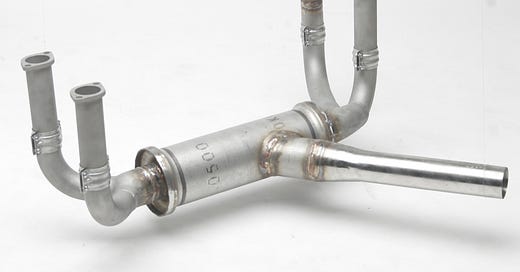When it comes to engine maintenance, we frequently pay attention to the usual concerns like the type of oil used and its consumption, fuel flow, and how to operate the engine properly. Your exhaust system is one component of your engine that is frequently overlooked until a serious problem arises. The proper operation and maintenance of this system is crucial to the general health of your engine.
There is a common misperception that exhaust systems serve only to handle the waste products of combustion and have no bearing on the remainder of the engine. Contrary to popular belief, most aircraft don’t simply throw their exhaust overboard.
Your exhaust system is made to remove gases swiftly and effectively from the combustion chamber. While some aircraft do this quite directly (think of a J3 cub or Cessna 140), others do it in a more roundabout way (think of early piper Cherokees). The engine's ability to "breathe" and, thus, produce its maximum horsepower, depends on how successfully it can expel exhaust gases.
Unfortunately, a lot of people who are not into aviation do not like the sound of unmuffled horsepower screaming overhead. Because of this, as well as for the benefit of our passengers' hearing, most aeroplanes are equipped with mufflers. Due to the requirement for a muffler, the exhaust flow must be redirected to a single location, necessitating the addition of numerous joints and bends to the system.
Although it may be less effective, this slightly decreases the flow and enables us to utilize the heat by-product that is produced during the exhaust. It is frequently used by aircraft as a source of cabin heating. Our biggest exhaust concerns occur inside the muffler itself, as well as the bends and joints required to send the exhaust gases to it
.
A steady and even flow through the exhaust system is important to ensure proper engine operation. Although an exhaust leak at a junction or in a pipe can seem insignificant, take this into account: Your exhaust system may function at temperatures as high as 1600 °F. While your pipes are built of stainless steel or Inconel, which can withstand such high temperatures, anything else directly exposed to the leak could be quickly damaged. Leaks can bend and harm your firewall or even melt important connections. Both of which require pricey repairs.
You should also keep in mind that your exhaust does not just release soot and carbon. There are multiple chemical components of an engine's exhaust gases, and the vast majority of these are damaging to your aircraft. Over time, even a small leak might result in serious corrosion problems. This is frequently observed at the exhaust flange of a leaking cylinder. The corrosive components of the exhaust gradually eat away at the cylinder, and if the problem is not fixed quickly enough, the flange will erode to the point where the cylinder cannot be repaired.
Another important thing to watch out for is the muffler itself. Most owners and pilots are aware of Airworthiness Directive (AD) CF90-03-R2 which requires the inspection of any exhaust-type heat exchangers. This AD was issued to ensure that no carbon monoxide is seeping into the cabin during cabin heat operation. This inspection is required every annual or 150 hours. Another part of the muffler to focus on are the internal baffles. Over time these baffles become warped and start to break apart which can cause problems within your exhaust. Badly warped baffles can cause uneven exhaust flow, which in turn causes temperature and pressure fluctuations within your system. While warping alone is usually not critical, a piece of baffle breaking off and blocking the tailpipe can potentially block airflow resulting in severe engine power loss
.
If your exhaust is damaged and needs to be repaired, a solution is not as simple as it once was. A skilled AME used to be able to do welding repairs, but this changed several years ago. Welding is now considered specialty maintenance; thus it must be done by an AMO who is certified in both exhaust repair and welding. It is crucial to keep in mind that not all AMOs have the right welding certification related to exhaust repair, so be sure to talk with your maintenance provider about any repairs you may require to make sure they are properly certified.
While exhaust systems might not be as entertaining to discuss as other engine upgrades, they are nevertheless a crucial part of your aircraft. Your safety as well as the longevity and performance of your engine will be increased by keeping the exhaust system properly maintained.
Fly Safe
.








